The Precision Rifle Series is a unique sport among riflery competitions. It’s not quite like bullseye competition since targets are engaged on a hit-or-miss basis, but neither is it really like action shooting sports. Instead, it combines the speed and efficiency demanded by dynamic sports like USPSA or 3-Gun with the precision and technical proficiency required by high-powered rifle matches.
PRS competition is growing in popularity quickly, especially in recent years, but the cost to get started can be daunting. Drop by a match and you’re likely to see an abundance of custom, high-dollar bolt-action guns, top-tier gear, and precision handloaded ammo.
Luckily, PRS offers a Gas Gun Division for those looking to practice or compete with semi-automatic rifles. It’s not the most prominent division in the series but does offer the lowest barrier to entry since most recreational shooters already own or are familiar with popular semi-automatics.
Of course, for a would-be competitor, that begs the question: which semi-auto? An AR platform of some kind is the obvious choice, having the widest range of available cartridges and accessories, but should you take an AR-15 or an AR-10? A small-frame rifle, or a large one?
Below, we’ll take a look at what factors contribute to a successful PRS rifle and how they impact the choice between a small-frame or large-frame AR-pattern firearm.
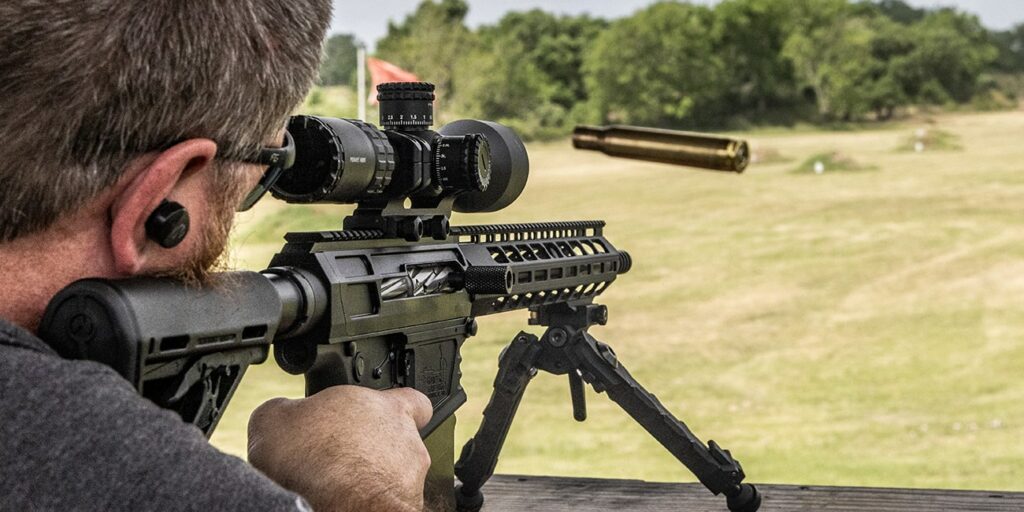
Attributes of a Good PRS rifle
PRS competition is a highly specialized purpose for a rifle. The sole objective is efficiently engaging targets at extended, unknown ranges. For that reason, the most important attributes in a PRS rifle are external ballistics and recoil.
Recoil
The importance of recoil, or rather a lack of recoil, is largely self-evident. Guns with less recoil are easier to shoot and less likely to induce flinching, regardless of whether they are rifles, pistols, or shotguns. Lower recoil also translates into the faster recovery of your sight picture.
In precision rifles, this makes it easier to spot your own impacts, which in the case of a miss can provide valuable information as to what went wrong with the initial shot, allowing you to correct your range estimation or wind call for a follow-up shot.
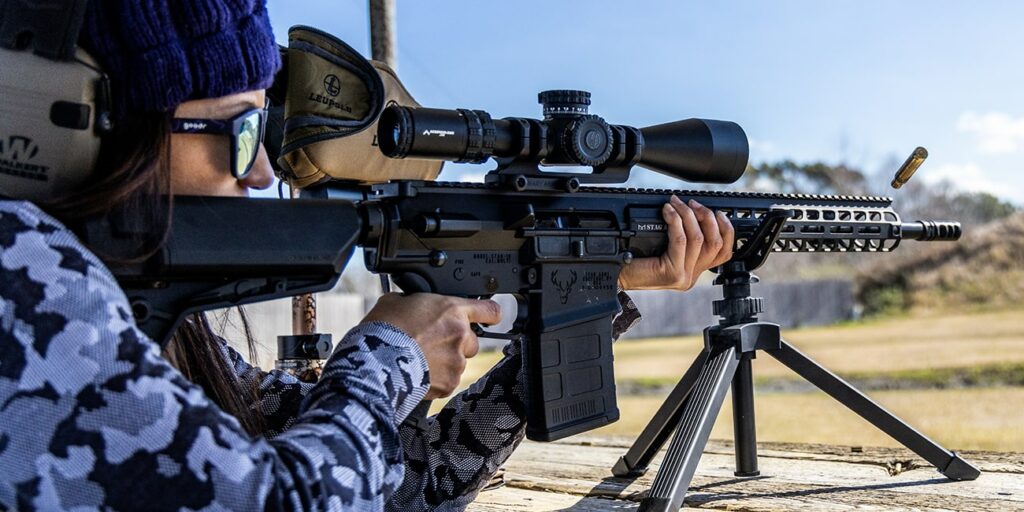
External Ballistics
External ballistics is essentially a catch-all term for everything a bullet does, from the moment it exits the muzzle to the moment it impacts the target. Velocity, drop, and ballistic coefficient are all part of this, and excluding personal skill, it’s probably the most important part of PRS competition.
The external ballistic performance of your rifle is going to primarily boil down to your choice of cartridge and your barrel length. All else being equal, a longer barrel will generate a higher velocity, which for identical rounds means a flatter trajectory.
External ballistics is a very complicated science and if we tried to cover every factor that contributes to a bullet’s performance in long-range precision, this article would be a textbook. What you need to know is this: flatter is better.
Shop all In-Stock AR-15 Barrels
When we talk about a bullet shooting “flatter,” we’re referring to how much it drops over a given distance. A round that drops less would be considered to shoot flatter than a round that drops more.
The biggest factors in how flat a round shoots are ballistic coefficient and velocity. Without getting too technical, ballistic coefficient is basically a measure of how well a bullet resists drag from the air while it’s in flight. Drag slows down the bullet, so a higher ballistic coefficient is a good thing, allowing a projectile to retain more of its velocity for longer.
A flat-shooting round is a big advantage in PRS because it makes range estimation more forgiving. Say you’re engaging a 12″ target. You estimate it’s at 500 yards. It’s actually at 518 yards. If you’re aiming dead center of the target and your cartridge has more than 6″ of drop between 500 and 518 yards, you miss. If it has less than 6″ of drop, you’ll still manage a hit, regardless of the error.
Flatter-shooting rounds with high ballistic coefficients tend to be more resistant to the wind, as well, making wind calls more forgiving in the exact same way as range estimates.
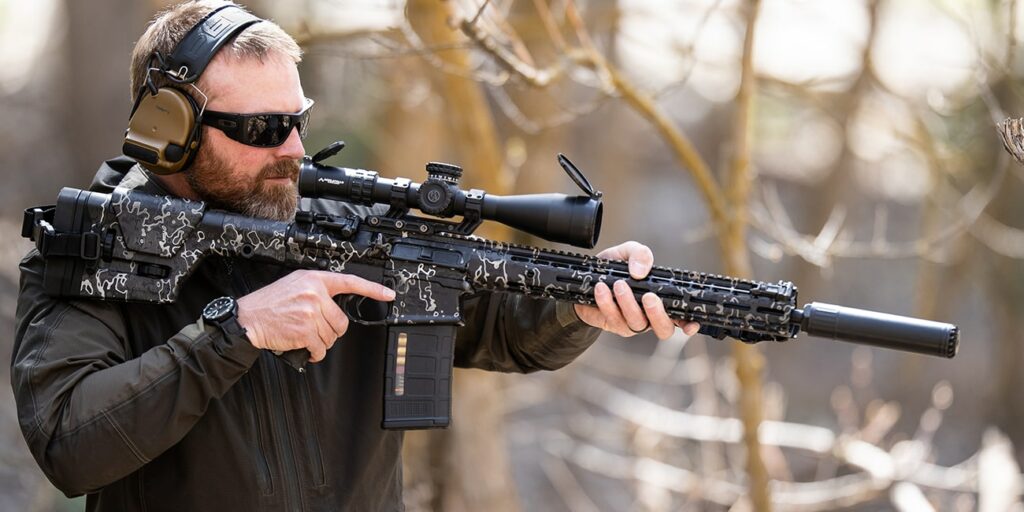
Weight, Terminal Ballistics, and Magazine Capacity
In most other pursuits, factors such as weight, terminal ballistics, and magazine capacity would play a much greater role, but these can be largely ignored for modern PRS competition. Weight does still play a small part, as a heavier rifle can make it slower or more difficult to move between positions and contribute to faster fatigue, but the 2-3 pound difference between most rifles is unlikely to be the difference between victory and defeat.
Terminal ballistics and magazine capacity can be major considerations for hunting and tactical applications, but for PRS, they’re essentially negligible. An average PRS stage will typically require 8-12 rounds to be fired, meaning that even a rifle limited to 10-round magazines would require only a single magazine change.
Shop all In-Stock AR-15 Magazines
Previously, terminal ballistic performance was an important consideration. Rounds like 6.5 Creedmoor came to the peak of their popularity during this time, as they delivered more energy on target and created a more visible impact, making it less likely for a spotter to fail to recognize the hit.
Now, though, the vast majority of PRS matches use electronic hit-detection equipment, which reliably indicates a hit or miss regardless of the amount of energy on target. For that reason, many top competitors have left 6.5 Creedmoor behind in favor of flatter-shooting and softer-recoiling rounds.
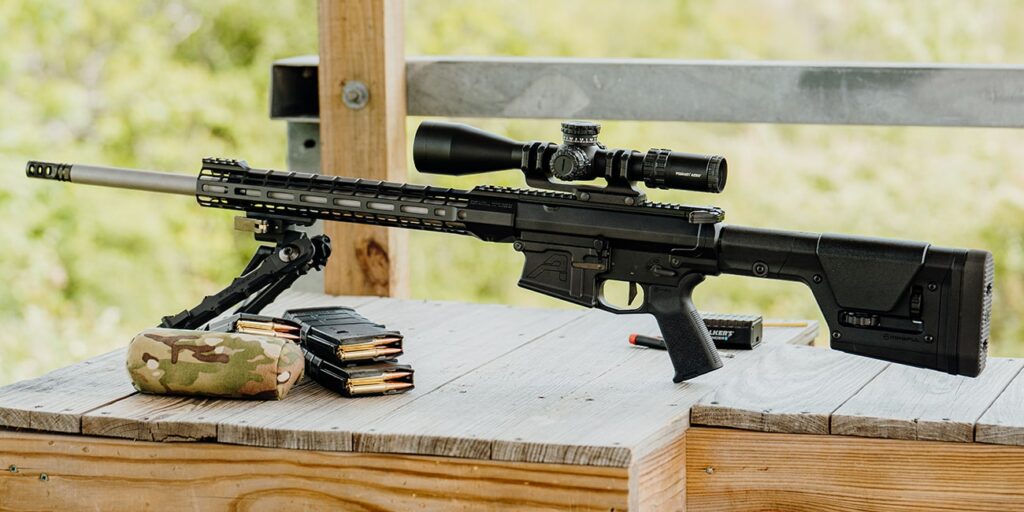
Cost
Some other minor considerations include cost and barrel life. Long-range precision marksmanship is not a cheap hobby at the best of times, but running a 6mm wildcat cartridge that burns out a barrel every 2,000 rounds is going to make it all the more expensive.
While the cost of ammunition and barrels doesn’t have any direct effect on the outcome of a match, more expensive equipment can make frequent practice cost prohibitive for those on limited budgets. If you have to choose between frequent practice with a less-capable but more affordable round and rare practice with an ideal cartridge, you should always choose the former.
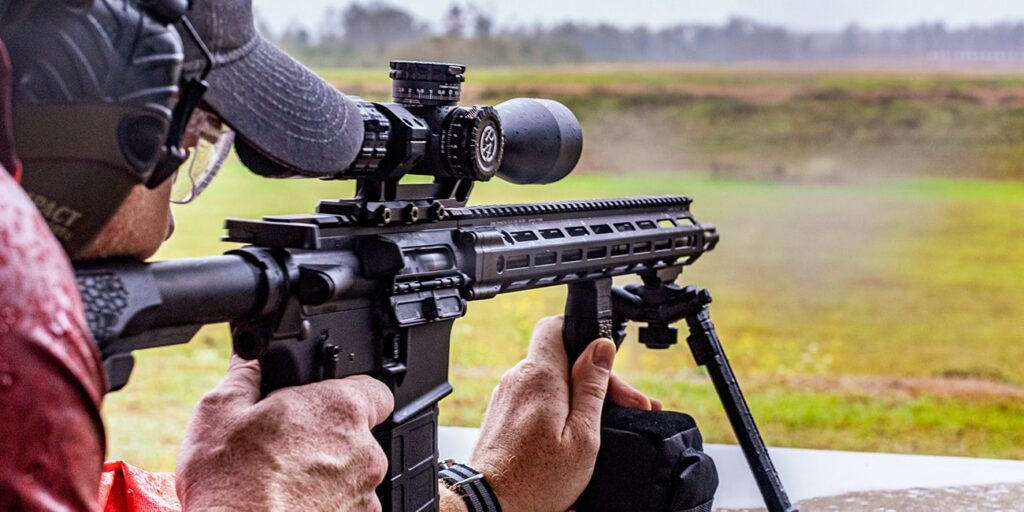
At the end of the day, the most important part of your loadout is what’s between your ears. No fancy wonder cartridge can make up for lack of ability or experience.
Small-Frame Vs. Large-Frame: The Match-up
When it comes down to it, there’s not a ton of difference between large-frame and small-frame AR platforms. They use the same triggers, the same safeties, and the same optics. Ergonomics and handling will remain relatively unchanged between the two, as will the manual of arms.
Shop all In-Stock AR-15 Triggers
For that reason, all of the above factors can be ignored when comparing the two platforms. Normally, things like ergonomics and trigger quality would be primary considerations when deciding between different rifles, but since those are identical in this case, we’ll take a look at only the factors that are different between the two and affect their performance in PRS: recoil, ballistics, and cost.
Small-Frame Vs. Large-Frame: Recoil
Recoil can be pretty different between rifles, even within the same frame size. There are plenty of AR-15s chambered in big, beefy cartridges that kick pretty hard; on the other hand, there are also ARs chambered in .22LR or .223 Remington that offer little to no recoil.
.223 Remington/5.56x45mm NATO is really the smallest, lowest-recoil cartridge that could reasonably be used for PRS competition. A well-tuned AR chambered in .223 with an efficient muzzle brake is going to have essentially no appreciable recoil. Even novice shooters will have an easy time controlling muzzle rise and getting back on target in time to see the impact—if they ever lose sight of the target at all.
Shop all In-Stock .223 Remington/5.56x45mm Ammo
Although large-frame ARs tend to be heavier and feature longer gas systems than AR-15s, the larger cartridges they’re generally chambered in also generate significantly more recoil. While a well-tuned AR in .308 Winchester or 6.5 Creedmoor certainly isn’t going to be hard to control, it’s never going to achieve that barely-existent level of recoil .223 guns are capable of.
A heavier large-frame AR chambered in a light-recoiling 6mm round might be able to get close to AR-15 levels of recoil, but at that point, you’re looking at fairly significant trade-offs in cost and weight.
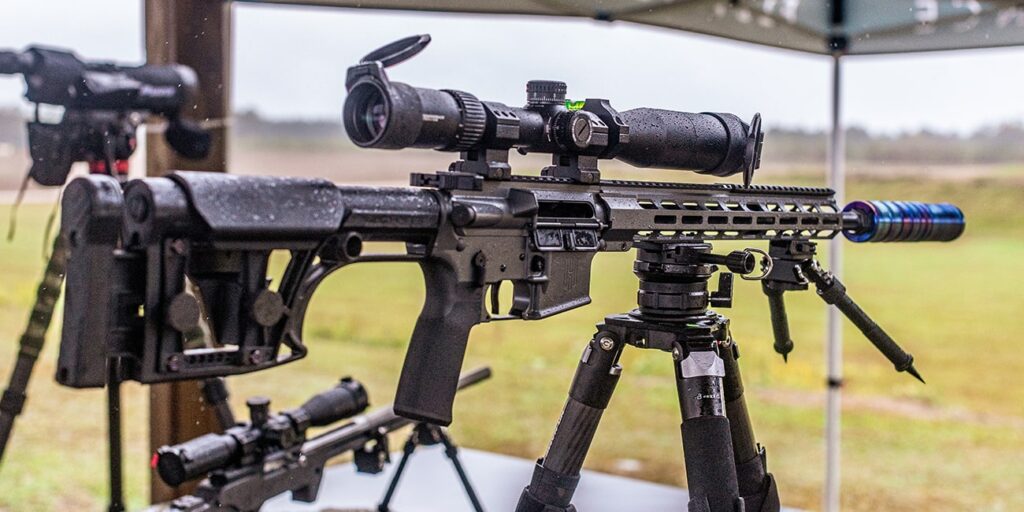
Still, large-frame ARs can achieve low enough levels of recoil that a moderately experienced shooter would have no trouble recovering their sight picture in time to spot their impacts. For that reason, we would give only a slight edge to small-frame ARs in this category, as there is a point of diminishing returns once you’ve reduced recoil enough to spot your hits easily.
Small-Frame Vs Large-Frame: Ballistics
Ballistics is the most significant of the three factors we’ll be looking at. You can make up for heavier recoil with good training, but there’s really no substitute for a flatter flight trajectory.
Small-frame ARs have come a long way in the past decade. Previously, your options for PRS-style marksmanship basically boiled down to .223 Remington and 6.5 Grendel. Now, there’s a whole smorgasbord of long-range precision rounds optimized for the AR-15, such as Hornady’s new 6mm ARC.
For those willing to handload their ammunition, there are a number of wildcat cartridges that manage to eke out even more performance.
Still, even with the impressive long-range performance of modern small-frame cartridges, such rounds are at a disadvantage when it comes to PRS shooting. Lower case capacity, shorter overall length limits, and a smaller bolt face all limit the performance of small-frame rifles in a way they simply don’t for large-frame guns.
Just as the AR-15 has benefited from a wealth of development and innovation these past few years, so too have large-frame ARs. Gone are the days when you had to choose between .308 Winchester and 6.5 Creedmoor; now, high-performance cartridges like 6mmXC and 6.5×47 Lapua allow competitors to build gas guns that rival even the performance of bolt-actions.
Shop all In-Stock AR-10 Rifles
While small-frame ARs have come a long way in terms of long-range performance, there’s no question that they’re outclassed by large-frame rifles. The increased chamber size and bolt face offered by the large-frame pattern allow heavier bullets with sky-high ballistic coefficients to be pushed out at over 3000 feet per second. At the same time, small-frame rifles would be limited to lighter, shorter bullets to achieve the same velocity. In terms of raw ballistic performance, large-frame ARs definitely take the victory.

Small-Frame Vs. Large-Frame: Cost
Most competitors don’t have unlimited budgets, and for many, PRS may not be the only competition vying for their time and money. While cost doesn’t have any direct impact on performance, it is a consideration that most marksmen will need to take into account.
AR-15s, obviously, take the win for this category. The AR-15 is one of the most common rifles in America, made by dozens of different manufacturers. They’re available in every size, budget, and color you could possibly want.
Where the AR-15 really pulls ahead in terms of cost, though, is in the price of ammunition. Mediocre .223 Remington ammo can be had for under 50 cents a round, even in today’s market. High-end precision ammunition from a respected manufacturer will still demand a premium, but handloading components for .223 are plentiful and inexpensive. The round also requires a fair bit less powder than your average large-frame AR cartridge.
Of course, high-performance cartridges like the 6mm ARC are going to be substantially more expensive than .223, both for commercially loaded ammunition or handloading components, but the fact remains that cost-effective ammo is available for the AR-15 for those willing to forgo cutting-edge performance.
In large-frame ARs, the cheapest available cartridge would be the .308 Winchester. It’s a mature round, one that’s been around for long enough that the market is absolutely saturated with options. Still, cheap .308 will on average cost around 50% more than cheap .223. That price gap narrows a bit when comparing match-grade ammunition, but even the cheapest large-frame AR cartridge will nearly always be more expensive than that of a small-frame AR.
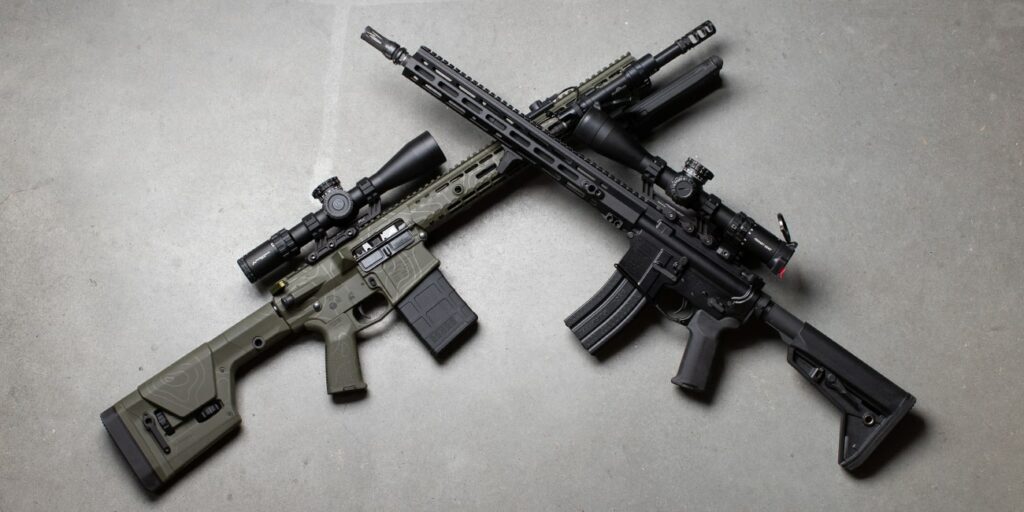
Summary
At the end of the day, there’s never any one perfect rifle for everyone.
Small-frame ARs benefit from negligible recoil and a relatively low barrier to entry at the cost of a certain level of performance. This makes them an excellent choice for those still unsure if they want to fully commit to PRS competition or those who already own an AR-15 and want to compete without having to buy and set up a new rifle.
AR-15s also make great training rifles for novices and veterans alike; while their faster rate of drop and lower wind resistance are liabilities in a match, this also makes them useful for training. They’re less forgiving of errors, pushing users to be more precise in their calls and holds. This combined with their lower cost of ammunition makes them ideal practice rifles for developing fundamental skills.
For those willing to bear the cost, large-frame ARs simply offer more performance than their small-frame counterparts are capable of. They’re bigger, beefier firearms, but those attributes don’t hold them back in PRS competition, and the increased chamber size, bolt face, and cartridge case capacity allow them to utilize more powerful flatter-shooting rounds.
If you don’t mind the expense and want the most competitive platform available, a large-frame AR is a clear choice.



